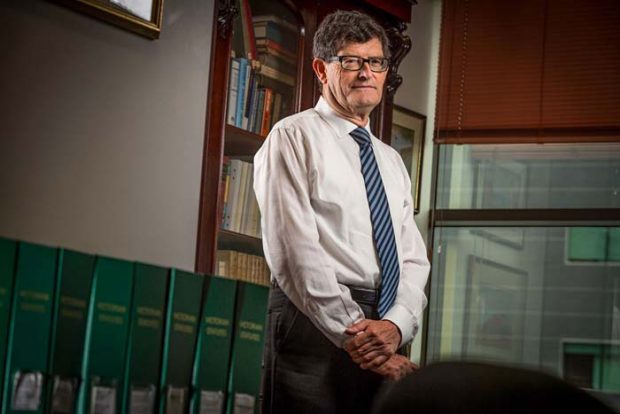A day in court
It’s the ‘engine room’ of the judicial system. Thousands of people – victims, defendants, witnesses and lawyers – pass through Victoria’s Magistrates’ Courts every day, all seeking justice. Gary Tippet takes a seat in the public gallery.
Back in his day, the defendant had a familiarity with tribunals of a different sort. In five seasons in the old VFL, the big footballer had thrown a punch or three and missed 30 games through suspension. He wasn’t fond of rule-keepers either, missing four of those matches for abusing the umpire.
Now 78, and a self-funded retiree, he finds himself in Court 11 of the Melbourne Magistrates’ Court, in furious disagreement with a traffic policeman over a penalty for using his mobile phone while driving.
In the officer’s version, he was spotted talking on the phone while in heavy traffic. Pulled over, he allegedly admitted: “You got me. I was talking to my wife, she’s in hospital.”
Nonsense, the big bloke tells Chief Magistrate Peter Lauritsen. His version is very different, a lot longer and much more complicated.
Greatly condensed, it goes like this: While on his way to visit his gravely ill wife in hospital, his phone rang.
He was wearing a Bluetooth earpiece, but its battery was dying and he could barely hear. So he pulled over at the first opportunity, switched off the radio and engine, removed the earpiece, took his phone from its pouch, took the call and quickly disconnected. It all took 46 seconds and he has the records to prove it. Only then did he notice the sergeant tapping on his window.
The matter has already been heard by a judicial registrar (a court member with delegated judicial functions), who found him guilty and ordered a $200 payment into the Court Fund. But the defendant was entitled to seek a review of the decision by submitting an affidavit – which is why he’s in the witness box before Victoria’s most senior magistrate.
However apparently minor, it is significant to the accused and demands proper consideration. Today the Chief Magistrate is sitting in Court 11 and like all magistrates hears whatever pops up. The increasing administrative duties of his position mean he does not sit in court as often as he’d like. He makes time to ensure he does sit.
Peter Lauritsen (BA 1973, LLB 1974) presides over Victoria’s 11 metropolitan and 42 regional Magistrates’ Courts. Appointed Chief Magistrate in November 2012, he is in charge of 105 sitting and 17 reserve magistrates, four deputy chief magistrates, more than 20 assorted co-ordinating magistrates, judicial registrars and Drug Court magistrates – and, by far, the state’s busiest court.
The Magistrates’ Court is “the engine room” of our court system, according to Lesley Fleming (BA 1981, LLB 1985), a magistrate in the Children’s Court.
“We deal with over 90 per cent of the cases that come before Victorian courts,” she says, estimating that more than a million people – offenders, prosecutors, witnesses and students – pass through its doors every year.
As a consequence, she says, the court has “an opportunity and an obligation to make that experience for court users one that is just, efficient and without undue delay”.
Volume is an issue, with huge pressure on magistrates to move through the daily lists in a timely way, Fleming adds.
Lauritsen points out that for most matters the Magistrates’ Court is the first point of entry into the court system. “If you consider the system as a pyramid, the County and Supreme courts are at the apex, and the bulk of the rest of the structure is the Magistrates’ Court.”
After beginning his secondary education in schools in England and Germany, where his father was posted as an Army electrical engineer, Lauritsen completed his matriculation in Melbourne. He entered Melbourne Law School in 1969, though geology had been a consideration.
“I took the view that I’d do better doing law than I would in geology, which is pretty much an up-and-down career, depending on the fortunes of the mining industry,” he admits. “But as I got into law I found I quite enjoyed it – the development of principle, preparing cases.”
In 1975, he joined the “robust people’s practice” of John Cain (LLB 1953), who became Premier of Victoria in 1982. In 1987, Lauritsen became a magistrate in the Northern Territory, returning to Melbourne two years later. He found the magistracy suited him.
“A magistrate has to be first and foremost impartial,” he says. “A magistrate in our court has to be decisive. You don’t have the luxury of putting it off to another day to think about it. You need a good judicial demeanour. You have to be patient with people. You’ve got to be hard working. And, I suppose, you have to be reasonably energetic to keep coming back at it all the time.”
This day in court, a couple of those qualities are being tested. The old ruckman is a talker, offering a long, meandering version of events, constantly digressing, and adding sound effects by tapping on the witness box. Even the soft-spoken magistrate’s renowned patience is tried and three times he gently steers the witness back to the point.
“A magistrate has to be first and foremost impartial.”
Eventually, after carefully weighing both versions of the story, Lauritsen finds him guilty of the original charge but dismisses it under a provision in the Sentencing Act.
Downstairs in Court 9, a procession of defendants passes before the bench, almost all seeking adjournments. It’s all fast, efficient and business-like.
None of it makes much impression on the skinny girl in black in the back row of seats. She keeps nodding off, slumping drowsily to the side. She’s still clearly under the influence of what brought her here.
“Wake up,” says her lawyer from the seat in front. “You’re up next.”
The Magistrates’ Court has never wanted for custom, but since 2013, after the murder of Jill Meagher and public reverberations over bail and parole, there has been “a truly massive increase” in the number of people on remand, says Lauritsen. The proportion of people on remand – in custody awaiting trial – has doubled from 18 per cent to 36 per cent, and the number is growing. Magistrates now hear 27,000 bail applications each year.
“No system can realistically cope with such a huge increase over such a short time,” he says, and one result was that the authorities were increasingly failing to present people from prison to court when required. The court has responded with a number of measures, including Saturday and Sunday sittings and more audio-visual links.
Now, a large flat screen flickers to life. A heavy-set, crew-cut, crooked-nosed man in a white T-shirt is appearing from prison for sentencing. Two weeks ago, he pleaded guilty on six counts of burglary, dealing with the proceeds of crime, and breaching a Community Corrections Order.
He gets a short lecture on the distress of victims and an aggregate sentence of five months’ jail, topped with another 12-month CCO. With 114 days already served, that means he has another 41 days to serve in prison. “Thank you, Your Honour,” he says.
In Court 5, a red-faced woman in her late 30s is less content, fidgeting unhappily under the withering gaze of Magistrate John Doherty (LLB 1986).
She is appearing in court on six matters, including shoplifting and theft. She has “an extensive history” of dishonesty, but her life has been “a tale of woe” of abuse and drug issues, pleads her barrister. But he knows he’s swimming against the tide.
“The uninformed look in on the system and criticise judges and magistrates, but don’t credit them when they get it right.”
Doherty, with a salt-and-pepper buzz cut, neat beard and call-it-a-shovel manner, peers over his glasses and pithily opines: “Until she gets over her drug issues she’s going to keep knocking off other people’s stuff and she’s going to keep going to jail. The head sentence is two-and-a-half years on the top, 12 months on the bottom.” It’s a long parole term, but she won’t get it unless she does all the programs attached, he adds.
The woman wears a look of outrage. “That’s massive,” she tells her lawyer. “That’s just bloody massive.” But she cops it.

“The uninformed look in on the system and criticise judges and magistrates, but don’t credit them when they get it right,” Bernie Balmer says. Picture: Steve McKenzie.
Defence lawyer Bernie Balmer (LLB 1982) – nicknamed Bernie the Attorney – has watched legions of defendants troop through these environs in the 46 years since he began as a Clerk of Courts at the old Melbourne Magistrates’ Court.
While studying at the University he also won an Australian university heavyweight boxing title, and in 1983 set up his own practice, specialising in criminal law and traffic matters.
Abolition of suspended sentences, increasing drug-related crimes and the rise in people on remand have built pressure on the Magistrates’ Courts, he says. “It’s become more of a factory now. We’ve got to a stage where I believe there’s an obscene haste with which justice is now being dispensed, which then creates enormous pressure on judges and magistrates.
“The system gets criticised unnecessarily. The uninformed look in on the system and criticise judges and magistrates, but don’t credit them when they get it right.”
Related stories:




